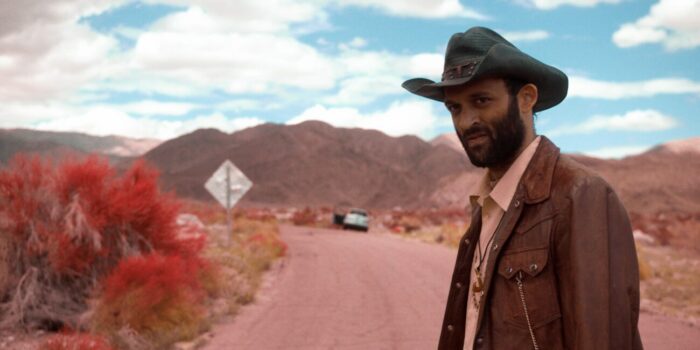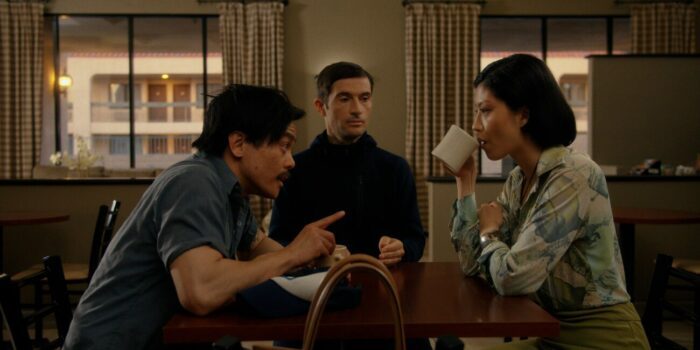Silent River opens with a noticeably long take, over three minutes long in fact, as its protagonist drives through a soulless desert. There’s nothing in front of him, and, as the camera slowly pans around to his right and settling on a perspective through the rear window, nothing behind. There’s no music, no dialogue, no ambient sound other than the hum of the engine and the tires on the road: nothing to give any clue to its protagonist’s mental state or destination. Where is he driving to, or from, and why?
It wouldn’t be quite right to compare the long take that opens Silent River, the third feature film release from writer/director Chris Chan Lee, with that of one like Orson Welles’ snaky, suspenseful slither through a Mexican border town in Touch of Evil or Sofia Coppola’s beguiling, enigmatically static shot starting Somewhere. Lee’s offers little narrative information and conveys next to no emotion: it’s at best a question-raiser and a bit of a time-killer, a shot that takes some dexterity to pull off but only delays narrative progress.

Only in the next scene does Silent River begin to outline its plot and adopt the tropes of a familiar genre as the driver, Elliott (West Liang) stops for reset at a roadside motel, where he phones his estranged wife, Julie (Amy Tsang), with whom he is desperate to reconcile. But she’s moved on, she tells him in no uncertain terms. From there, the drama is limited primarily to Elliott’s motel room, where he nurses his emotional wounds and drowns his sorrows in a sequence that recalls Martin Sheen’s Saigon-sh*thole breakdown at the start of Apocalypse Now, replete with ceiling fan if not The Doors.
From there, Silent River adopts, mostly, the tropes of neo-noir: paranoid and obsessive, Elliott snaps out of his downward spiral just long enough to meet Greta (Tsang, in a dual role) poolside. She’s somehow Julie’s doppelgänger, and she has her own secrets, including, not entirely coincidentally, an adjoining door at Elliott’s motel and a large, heavy cardboard box, one just big enough to hold a human body. So: Silent River has a doomed, wayward protagonist tortured by his past and a sultry stranger with her own secrets. Most of the film’s subsequent action takes place as Elliott, intrigued by Greta, hopes now to learn her secrets even as he pines still for Julie.

A film that from here explored the developing triangle between the three, evoking, as the set-up does, its neo-noir adjacency with the usual set of double-crosses, revelations, and labyrinthine twists and turns one associates with the genre, would certainly work well enough. Yet there’s more, and from here Silent River takes another turn, now towards a David-Lynch-meets-Black-Mirror surrealism: Greta’s box contains a lifeless body, but not a corpse. The contents drive the film into the territory of science fiction, where, frankly, all of its purpose and promise feels strained.
What is, then, Silent River? Its title gives scant clue: there’s no river, at least not literally. There is a mysterious roadside stranger (credited as “The Stranger”) who imbues opaque incantations with Log-Ladylike obscurity. The film wants to ask viewers to consider the impact of the past on our present, of our minds on our bodies, of our perception on our surroundings. But those are more like loose threads than they are coherent themes.

Lee’s film is shot with some impressive panache, especially in the desert scenes evoking a barren Western landscape, a rugged and isolated America where dreams go to die, and in a set of visual flourishes and animations that convey his characters’ altered states. Silent River is at its best in the outdoors of its American West where Lee can explore and experiment. Unfortunately, it spends more of its time locked indoors in Elliott’s and Greta’s spartan motel rooms, where the lead characters exchange lines of dialogue but no chemistry and little insight.

As it turns out, Silent River feels like two, or maybe even three, underdeveloped films in one. There’s a promising New Hollywood-like lovelorn-loner-on-the-run film, there’s a seedy-motel neo-noir, and there’s a sci-fi channeling Altered States through the acid Western. Together, though, the film suffers from a lack of coherence, and its leads, try though they might, can’t quite pull the film together through its disparate, if promising, sequences.
Following a successful festival run, Silent River will show theatrically Oct. 14 at the Laemmle Glendale and then be available on VOD beginning Oct. 25.



